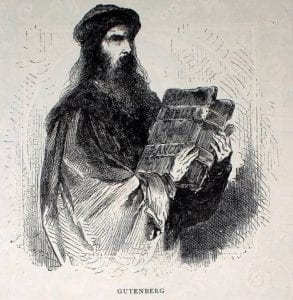‘Type is clothing for words’ – Erik Spiekermann
During a lecture we were taught about the origin of printing and different types. This was a very informative lecture because I learned all about the importance of typography. Types matter because they have to represent a person or brand or business, for example certain fast food chains wouldn’t use the same type as other professional fine dining establishments. Realising this, I came to understand that type has to be considered in everything and everyday life.
The discovery of Printing
Typefaces originated from ancient calligraphy and the printed manuscripts in China, they invented woodblock printing during the Tang Dynasty. One of the first books ever printed with woodblocks was a copy of the Diamond Sutra (846 AD), a six sheet scroll over five metres long. Chine also invented the first movable type, many thought that it was Johannes Gutenburg was the inventor of mobile type but he was not, the Chinese did. Fast forward to the 15th Century, Gutenberg was a ‘Revisionary’ and built on the work of the Chinese. He invented the adjustable mould and created type made from lead, tin and alloy. Gutenberg also invented the first printing press.
The Printing Press
The printing press is one of the most important inventions of all time. This cheap, quick and easy distribution would lead to changes in history forever, it revolutionised book making and distribution around the world. The printing press was so important because prier to this invention book making was a painfully long and laborious process and only the wealthy could afford them.
Gutenburgs device enabled the establishment of an early assembly-line production of printed text allowing for the mass production of books at a much cheaper cost than contemporary methods. His first book he produced was the Gutenberg bible and over 200 books were have said to be made and only 22 remain today.
This device had an impact on topics of religion as well for example, before the printing press Europe was predominantly Catholic due to the Church during the time of the printing press creation people again to rebel against the church and they began to reform and this contributed to the Protestant reformation, as people were spreading their own thoughts and ideas with ease because of books.
The Industrial Revolution
The industrial revolution introduced printing presses that required 90% less force but allowed for space for double the amount of paper, therefore the industrial revolution helped to advance the printing press and enhance the production greatly.
At the beginning of the revolution, the mechanics of the hand-operated Gutenberg- style press were still unchanged, although new materials in its construction, amongst other innovations, had gradually improved its printing efficiency. By 1800 a press made completely form cast iron was made by Lord Stanhope, this reduced the force required by 90%, while doubling the size of the printing area.
Patented in 1801, a German printer Friedrich Koenig made a stream press, this then let to the production of newspapers, they went on to prefetching this project so it could print on two sides of the paper.
A brief History of Typefaces & Typography
In professional typography, the term typeface is not interchangeable with the word font because the term font has historically been defined as a given alphabet and its associated characters in a single size. Historically, fonts came in specific sizes determining the size of characters, and in quantities of sorts or number of each letter provided. The design of characters in a font took into account all these factor.
The first font was said to have been developed from the scribes until the invention of the printing press. The first typeface carved by Gutenberg was derived from the hand writing style at the time and was used in the first books, even the bible.
Over time different styles were altered and favoured by the people, for example the classic ‘serif’ or ‘old style serifs’ were popular in the 15th century and was known as the ‘Garamond’ type. In 1934 Rockwell was designed by the monotype corporation and has remained popular to this day.Then there were fonts like Baskerville which was in-between the periods of old-style and modern fonts.
The Printing Revolution
These are some of the classic typefaces that have become timeless for example Palatino, this type was made in 1949 by Hermann Zapf and was so popular at its time and now because it is very easily read and still looks sophisticated on the page. Others like Futura, that was designed by Paul Renner and was the font they used for the moon landing, still appears to be a modern style. This typeface is interesting because it was made up of shapes and is still used thoroughly today. Another timeless classic is Helvetia, designed by Max Miedingers in 1957 and is one of the most well known and most used typefaces throughout the world for its neutral qualities and great clarity.
Web Typography
Web fonts needed to start because people could only access fonts that were on their computers web browser. There was no mechanism for individual web pages to control font display until Netscape introduced the font element in 1995, however the font had to be installed onto the computers system for them to be used. The Cascading Style Sheets specification was published in 1996 and provided the same capabilities. The CSS3 included font downloading and this is increased interest in web typography, as well as the use of font downloading.
I researched modern types and these are some I found that I thought were interesting,










